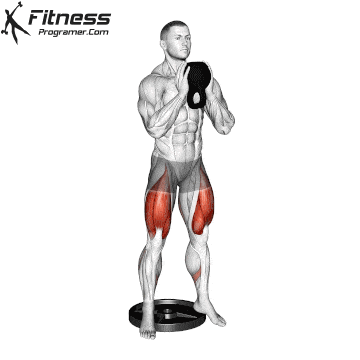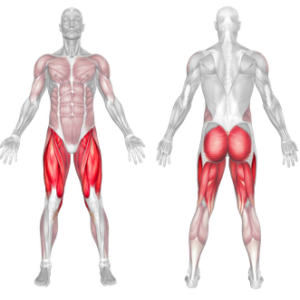Overview
The Heel-Elevated Goblet Squat is a squat variation performed with the heels raised on a wedge or plate while holding a dumbbell or kettlebell at chest level. This position allows for a deeper squat with improved knee tracking and less forward lean. It’s commonly used to emphasize quadriceps engagement, improve ankle dorsiflexion, and reinforce proper squat form.
How to perform Heel-Elevated Goblet Squat

Stand with your heels elevated on weight plates, squat wedges, or a slant board, and your toes flat on the floor.
Hold a dumbbell or kettlebell vertically at chest level with both hands (goblet grip).
Keep your chest tall and core engaged as you begin to descend.
Squat down slowly, allowing your knees to travel forward over your toes while maintaining heel contact with the elevated surface.
Lower to full depth, ideally until your hips are below your knees, then press back up through your midfoot and heels.
Perform for 8–12 reps, focusing on control and posture.
Tips for Proper Form
Use a stable surface (e.g., plates or wedges) to elevate the heels evenly.
Maintain an upright torso, especially at the bottom of the squat.
Keep the dumbbell close to your chest to avoid leaning forward.
Allow knees to travel forward, especially to target the quads.
Brace your core throughout the movement to protect your lower back.
Common Mistakes
Lifting the toes, which destabilizes the squat and shifts the weight too far back.
Letting the chest fall forward, reducing quad emphasis.
Using unstable or uneven elevation, risking imbalance or poor mechanics.
Not squatting deep enough, which limits mobility and quad activation.
Holding the weight away from the chest, which increases strain on the shoulders and spine.
Benefits of the Heel-Elevated Goblet Squat
Improves Squat Depth: Elevating the heels reduces ankle mobility demands, helping you squat deeper safely.
Enhances Quad Activation: Shifts emphasis toward the quads by allowing the knees to travel further forward.
Boosts Ankle and Hip Mobility: Promotes dorsiflexion at the ankle and improved movement mechanics at the hips.
Teaches Upright Posture: Encourages a vertical torso, which is essential for clean and front squat variations.
Reduces Low Back Strain: Limits excessive forward lean, reducing pressure on the lumbar spine.
Great for Beginners: Simplifies squat mechanics while improving form and confidence.
Versatile and Minimal Equipment: Requires only a weight and heel elevation—ideal for home or gym training.
How to Incorporate Into Your Routine
- For Beginners: Perform 2–3 sets of 10–12 reps with light weight and a moderate heel lift.
- For Hypertrophy: Use 3–4 sets of 8–12 reps with a challenging dumbbell to build quad size.
- For Strength: Do 4 sets of 6–8 reps with a heavier load and longer rest between sets.
- For Functional Training: Combine with single-leg work or mobility drills to improve squat mechanics.
- For Circuit Training: Add to a lower-body circuit with push-ups or rows for metabolic conditioning.
- For General Fitness: Include as a weekly lower-body staple to enhance strength and posture.
- For Mobility Work: Use lighter weight and focus on squat depth, control, and knee tracking.
Heel-Elevated Goblet Squat: Muscles Worked

Frequently Asked Questions
Why elevate the heels in a goblet squat?
It improves depth, posture, and quad targeting—especially if you lack ankle mobility.
How high should the heel elevation be?
1–2 inches is ideal for most people. Use squat wedges, plates, or a slant board.
Can this help with front squats?
Yes. It builds strength and positioning similar to the upright torso needed in front squats.
Is it okay if my knees go past my toes?
Yes. In this context, forward knee travel is encouraged for better quad engagement and depth.
Can I do this with knee pain?
If done with good form and light weight, it may improve knee mechanics—but consult a professional if pain persists.
